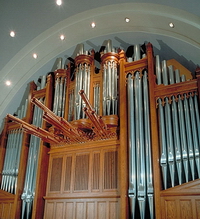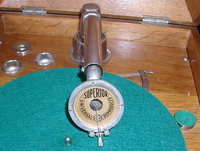|
Practicing Phonograph History
(with apologies to the late Barbara W. Tuchman)
by Keith Wright
When this newsletter arrives it will be approximately eighteen months since Lloyd Swakhammer, then Past
President of the London Radio Club, conspired with me to challenge CAPS to do something about preserving
the history of Canadian phonographs. So far we don't seem to have much to show for it and as time goes by
more and more is lost. I realize it won't be easy. What follows is a description of when I attempted to
practice some Real History a few years back. First I'll describe why it even happened.
When I began inquiring about a certain machine built in the province of Quebec I was essentially greeted with,
"Yes, we see them in the flea markets from time-to-time. So what?" But my background already had me
'sensitized' to them. My grandfather was a church organist in Liverpool, England; my parents sang with church
choirs all their lives; and I was invited by the choirmaster to sing with the adult choir at age 9 or 10 -
probably at least in part to remove barriers to my mother's attendance at practice. Instead of going to rock
concerts, I went to recitals by the likes of E. Power Biggs, Gillian Weir and Virgil Fox (purists are allowed
to shudder). I also have some actual organ pipes kicking around the house from when an organist conducted a
midnight pipe-ectomy for souvenirs after the pipe organ was sold (to be replaced by an electric thing). So
when an acquaintance (who studied with a master cabinet maker and could return kindling to drop-dead
factory-fresh machines) mentioned he had a "Casavantee" [sic] for me, my radar went off. "Where
does it say it was made?" "Saint Hyacinthe." I needed to see it. Then I needed to have it. Then
I needed to know more about it.
The machine that now graces our upper landing looks very much like a Victor Victrola VV-IX in oak. They have
similar dimensions, same basic styling and essentially the same technology including a manually set automatic
stop. The tone arm and reproducer are branded 'Superior Universal Reproducer', which is one of the 'clone' firms
operating in Chicago after the major Victor/Columbia patents expired. It is of the type that you can flip to play
either lateral or hill-and-dale cut records. I imagine this was a selling feature in Quebec to degroove those
French language Pathé records. (I have noticed that the machine has sounded its happiest playing a
Phonola hill-and-dale record.) The motor is a surprisingly light weight double-spring model helpfully stamped
with 'The Motor'. But it is the woodwork on the Casavant's internal horn that says 'organ maker' to me. Pipe
organs need to be encased in wonderful carpentry to lift the spirit visually as well as sonically. I like
taking off the chintzy front grill and looking at the internal horn. The 'volume control' also makes me think
of an organ stop. Enough about the machine, what about the history?
As we know, when internal-horn disc machines went into their 'clone phase' (much like PCs some years back)
they were routinely cobbled together by firms in other lines of business: aircraft manufacturers, piano makers,
furniture makers and organ builders. In order: Curtiss; Heintzman and Brantola; McLagan and Pollack/Phonola/Electrohome;
and Casavant. Casavant Frères opened in 1879 at Sainte Hyacinthe, Quebec. The brothers were following in the
footsteps of their father, who had been making pipe organs since 1840, including the largest one then in North America for
the cathedral in Bytown (now Ottawa). "By 1996 the firm had delivered more than 3,750 instruments and continued to
dominate the North American market, without neglecting its exports throughout the world." (From The Canadian Encyclopedia.
There is also an award-winning one-minute history seen as a commercial on TV. Casavant's web site currently lists 'Opus 3765'.)
I adopted a 'direct approach' and sent an un-guided missive into Casavant Frères, Ste. Hyacinthe, PQ. A reply eventually
came from 'The Assistant To The Tonal Director':
Thank you for your message and information.
Casavant Frères built phonographs between 1919 and 1926 using RCA turning table.
Thank you for your interest.
RCA turning table? I don't think I need to get into the details as to why this reply had serious credibility gaps for me.
Later I was told that everything had been sent to the 'museum of civilization' so, following this clue, I tried the Canadian
Museum of Civilization in Hull, Quebec (anyone spot my mistake?). When the museum searched their on-line catalogue they told
me "no phonographs here" and steered me to the Canada Science and Technology Museum (NSTMC). That's how I met Bryan
Dewalt. I thought I was getting somewhere since there is a picture of an upright Casavant on that museum's website. Bryan
kindly copied some Casavant catalogue pages for me and told me about a book on the firm that very briefly (don't blink) mentions
phonograph production. He also sent: "Casavant Frères established La Compagnie de Phonographes in St-Hyacinthe, Que
in 1919. Not known if they built them before but from 1911 to 1918 Casavant built cabinets for Victor Talking Machine at its plant
in South Haven, Michigan. The St-Hyacinthe subsidiary was dissolved in 1927 - don't know if all phonograph production was ceased.
No production figures."
The museum's machine is believed to be a No. 125 but the grill is different. I have a similar problem in that my tabletop looks
like a No. 50 but the grill matches the No. 100 upright and the plate inside says 270 (Model#? Serial#?). Bryan also said that
there was a wealth of material in Casavant's extensive archives! But Casavant said they'd sent everything to ... round and round
we go.
Armed with this information, I contacted Robert Baumbach about Casavant's making Victor cabinets out of the Michigan plant. Bob
stopped looking for the dog long enough to shoot that down instantly with: "Victor always built their cabinets themselves.
They never used a third party."
I did painstakingly go through the (French language) pages in Casavant Frères, 1879-1979 by Laurent Lapointe and put
together a rather interesting story:
[Because] of their competence "in the questions of sonority and the laws of acoustics", and experiments in [cabinetry],
[Casavant] undertook the manufacture of phonographs. To this end, in 1919, they incorporated another company with limited
responsibility [called] La Compagnie de Phonographes Casavant Limitee. This enterprise was really born in the factory since the
first machines were initially made by some employees eager to get a gramophone [cheaply](!). This practice authorized by the
owners was transformed soon into [a] serious project and, after a few months of studies and experiments on various apparatuses,
[they began] the manufacture of an instrument that gave satisfaction to the Casavant brothers. At the beginning [they] did not
seek to produce [machines] in great quantity, but the reputation of the Casavant phonograph was propagated rather quickly from
Saint-Hyacinthe and those which visited the organ factory did not fail to underline [the] quality of it. These first successes
[led] the Casavant brothers to consider the prospects [for going into this business] and the decision was made to [increase]
their production and to incorporate the company in 1919. A building was bought and [they] installed the necessary production
equipment. After one year, 20 employees under the direction of Joseph Touchette, the former harmonist as a chief of the branch
of South Haven, produced 13 different models for which the demand became so strong that it surpassed production capacity (!).
Successes of this company were short and "the acquisition of [the remaining] woodworking machines and the motors of La
Compagnie de Phonographes Casavant" by the organ enterprise put the end definitively of the manufacture of phonographs in 1927.
By the way, the catalog pages from NSTMC show only 9 machines, not 13. I have seen two other examples of my machine in the 'antique
corridor' between Montreal and Quebec City bearing slightly different models of the 'Superior' tone arm. Also, there was one sad
lidless Casavant tabletop relic labeled 'Phonographe de La Patrie' (Gramophone of the Fatherland) I discovered in Ontario.
So, now I'm stuck. I finally figured out (with something Jean Paul Agnard wrote in passing) that the museum that Casavant likely
graced with their documents is the Musée de la civilization in Quebec City! Duh! Given the geographic distance and my
grade 11 French I now leave it to others to expand on this story with a full catalog of models and production figures - and
find out if Casavant really did build anything for Victor. However, I submit this material (along with more pictures) to a future
CAPS Canadian Phonograph Encyclopedia.
And I still had a good time telling my father on the phone, "I have a Casavant in the house." I wish I could have seen
his face.
For further reference:
www.casavant.ca
www.sciencetech.technomuses.ca (search for phonograph)
Casavant Frères, 1879-1979, Laurent Lapointe (Société d'histoire régionale de Saint-Hyacinthe, 1979)
Got any information on Brantolas from the Brantford piano maker? Got an idea for a 'blank page'? Contact Keith at info@CAPSnews.org
|

Casavant Organ, "Opus 1409", Holy Rosary Cathedral Regina, Saskatchewan, Canada. Visually and sonically soaring. (Casavant Frères)

One of the old buildings still standing at the working factory.(Keith Wright)

Casavant model 270 (?) is similar to a VV-IX. (Keith Wright)

Casavant offered competitive options. (Keith Wright)

Models used hardware from a third party in Chicago. (Keith Wright)

Model 270? Serial number 270? (Keith Wright)

Lidless tabletop ghost from an Ottawa area dealer. Labeled 'Phonographes de La Patrie'. Reminiscent of other makes. (Keith Wright)

Different grill from my 'model 270' available in oak or mahogany. (Catalog courtesy NSTMC)

Fancy mahogany model. (Catalog courtesy NSTMC)

The Casavant gramophone at the National Museum of Science and Technology. (Courtesy NSTMC)
|